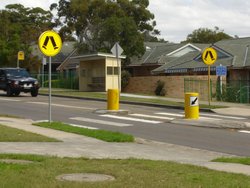Zebra crossing
|
|
A zebra crossing is a type of pedestrian crossing used in the UK and Europe, and increasingly around the world. The crossing is characterised by longitudinal stripes (hence the term, named after the zebra) on the road, parallel to the flow of the traffic, alternatingly a light colour (usually white) and a dark one (painted black, or left unpainted if road surface itself is of a dark color). The stripes are 40 to 60 centimetres wide. The crossings were originally marked by beacons (see below) and parallel rows of studs, but stripes were soon added for the sake of visibility.
The zebra crossing was first used (after some isolated experiments) at 1000 sites in the UK in 1949, and a 1951 measure introduced them into law. In 1971, the Green Cross Code was introduced to teach children safer crossing habits (replacing an earlier "kerb drill").
In the United Kingdom the crossing is marked with beacons on either side of the road, called Belisha beacons. These are black and white poles topped by flashing orange globes. They are named after Leslie Hore-Belisha, the Minister of Transport who introduced them in 1934. Pedestrians have right of way on this kind of crossing once they have put a foot upon it; cars then have to stop and give way, if they can do so safely.
This is in contrast to a similar crossing, known as a pelican crossing (pedestrian light controlled), which is marked with traffic lights for the vehicles and a green and red man lighting up to show pedestrians when to cross and when to stay. Pedestrians only have right of way here when the green man is lit. Pelican crossing were first introduced in 1969 (after an earlier experiment known as the Panda crossing) and in many places have completely replaced zebra crossings.
Other similar crossings in the UK include puffin (pedestrian user-friendly interface), toucan (two can cross — a joint pedestrian and bicycle crossing), and pegasus (for horses, usually outside race courses) crossings.
A zebra crossing famously appears on the cover of The Beatles' Abbey Road album. This is probably the world's most famous zebra crossing, and has even been incorporated into the current Abbey Road Studios logo. However, since the Abbey Road photo was taken, zigzag lines at the curb and in the centre of the road have been added to all zebra crossings to indicate the no-waiting zones on either side.
A "lollipop man" or woman helps children to cross a zebra crossing during school hours, so called for the long lollipop-shaped pole they carry, with a circular disc edged in red. The centre of this disk has a black bar. This is for the lollipop person to write down with chalk the number plate of any trangressing cars.
In the Netherlands, pedestrians have right of way only if they are standing close to the zebra crossing on the side of the road.
In Finland, the zebra crossing is also used by cyclists.
See pedestrian crossing for equivalent crossings in other countries, including North American "crosswalks".
References
- History of Road Safety (http://www.driveandstayalive.com/info%20section/history/history.htm), Gerald Cumminsnl:Zebrapad

